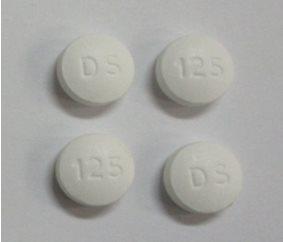D-Penamine and Alcohol/Food Interactions
There are 2 alcohol/food/lifestyle interactions with D-Penamine (penicillamine).
Penicillamine Multivitamins With Minerals
Moderate Drug Interaction
ADJUST DOSING INTERVAL: Oral administration of aluminum, copper, iron, zinc, magnesium, and possibly other minerals such as calcium may decrease the gastrointestinal absorption of penicillamine, and vice versa. The proposed mechanism involves chelation of penicillamine to polyvalent cations, which leads to formation of a nonabsorbable complex. In a study of six healthy volunteers, administration of penicillamine (500 mg) following a single dose of ferrous sulfate (300 mg) or antacid (Maalox Plus 30 mL) reduced the mean peak plasma concentration of penicillamine by 65% and 34%, respectively, compared to administration in the fasting state. In addition to chelation, some investigators suggest that antacids may also reduce penicillamine bioavailability by increasing gastric pH, which favors the oxidation of penicillamine to its poorly absorbed disulfide form. These changes could result in diminished therapeutic effects of penicillamine.
MANAGEMENT: Mineral supplements or other products containing polyvalent cations (e.g., antacids or preparations containing antacids such as didanosine buffered tablets or pediatric oral solution) should be administered at least two hours before or two hours after the penicillamine dose. In addition, pharmacologic response to penicillamine should be monitored more closely whenever these products are added to or withdrawn from therapy, and the penicillamine dosage adjusted as necessary. When penicillamine is coadministered with Suprep Bowel Prep (magnesium/potassium/sodium sulfates), the manufacturer recommends administering penicillamine at least 2 hours before and not less than 6 hours after Suprep Bowel Prep to avoid chelation with magnesium.
References
- Osman MA, Patel RB, Schuna A, Sundstrom WR, Welling PG (1983) "Reduction in oral penicillamine absorption by food, antacid and ferrous sulfate." Clin Pharmacol Ther, 33, p. 465-70
- Harkness JA, Blake DR (1982) "Penicillamine nephropathy and iron." Lancet, 2, p. 1368-9
- Netter P, Bannwarth B, Pere P, Nicolas A (1987) "Clinical pharmacokinetics of D-penicillamine." Clin Pharmacokinet, 13, p. 317-33
- Joyce DA (1989) "D-penicillamine pharmacokinetics and pharmacodynamics in man." Pharmacol Ther, 42, p. 405-27
- (2001) "Product Information. Cuprimine (penicillamine)." Merck & Co., Inc
- Haagsma CJ (1998) "Clinically important drug interactions with disease-modifying antirheumatic drugs." Drugs Aging, 13, p. 281-9
- Lyle WH (1976) "Penicillamine and iron." Lancet, 2, p. 420
- (2010) "Product Information. Suprep Bowel Prep Kit (magnesium/potassium/sodium sulfates)." Braintree Laboratories
Penicillamine Food
Moderate Food Interaction
ADJUST DOSING INTERVAL: Food may interfere with the gastrointestinal absorption of penicillamine. In a study of six healthy volunteers, administration of penicillamine (500 mg) following a standard breakfast reduced the mean peak plasma concentrations of penicillamine by 48% compared to administration in the fasting state.
MANAGEMENT: Penicillamine should be administered on an empty stomach, at least one hour before or two hours after meals, and at least one hour apart from any other drug, food, or milk. This permits maximum absorption and reduces the likelihood of inactivation by metal binding in the gastrointestinal tract.
References
- Osman MA, Patel RB, Schuna A, Sundstrom WR, Welling PG (1983) "Reduction in oral penicillamine absorption by food, antacid and ferrous sulfate." Clin Pharmacol Ther, 33, p. 465-70
- (2001) "Product Information. Cuprimine (penicillamine)." Merck & Co., Inc
D-Penamine drug interactions
There are 105 drug interactions with D-Penamine (penicillamine).
D-Penamine disease interactions
There are 5 disease interactions with D-Penamine (penicillamine) which include:
More about D-Penamine (penicillamine)
- D-Penamine consumer information
- Check interactions
- Compare alternatives
- Drug images
- Side effects
- Dosage information
- During pregnancy
- Drug class: antirheumatics
- Breastfeeding
Related treatment guides
Drug Interaction Classification
| Highly clinically significant. Avoid combinations; the risk of the interaction outweighs the benefit. | |
| Moderately clinically significant. Usually avoid combinations; use it only under special circumstances. | |
| Minimally clinically significant. Minimize risk; assess risk and consider an alternative drug, take steps to circumvent the interaction risk and/or institute a monitoring plan. | |
| No interaction information available. |
Further information
Always consult your healthcare provider to ensure the information displayed on this page applies to your personal circumstances.


